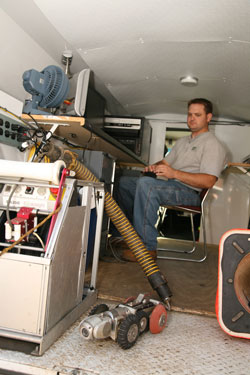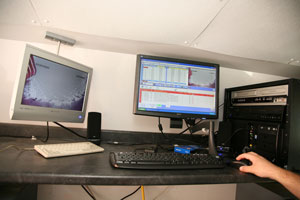Two decades ago, EST Associates, Inc. started operations in Needham, Mass., to provide the New England area with environmental sampling and related monitoring services.
Driven by the demands of a growing customer base including engineering and consulting firms, remediation contractors, local municipalities and wide ranging industries, EST has expanded its capabilities to a new selection of O&M services, site remediation and pipeline inspection programs. John Carlin, president and owner, credits the company's 20 percent growth in profitability during the past few years to EST's ability to capitalize on the area's growing needs. "We listen carefully to clients and prospects and, in many cases, expanded existing services or added new ones to meet their needs," says Carlin. "This is especially true with our pipeline services division, which was introduced several years ago to identify potential sources of inflow and infiltration in sewer and wastewater piping systems.
"Since its launch, that division alone has several new customers and expanded business with several others, including local municipalities and public agencies. For many cities and towns, it is a constant battle to ensure the constant and unobstructed flow of their aging lines and to identify sources of inflow and infiltration since in many cases, these lines were built in the early 1900s."

EST's Geoff Beyer performs all operations inside or from the outpost van, including video footage review and software assessment and integration.
Based in eastern Massachusetts, just 10 miles southwest of Boston, EST serves one of the largest, most densely populated metropolitan areas in the United States. Home to 4.4 million individuals, Greater Boston provides numerous maintenance challenges for local communities and public works departments since the terrain ranges dramatically from sprawling urban centers to wide tracts of forests, wetlands, open spaces and waterways.

Geoff Beyer uses WinCan v8 software to make critical maintenance and repair decisions based on video footage captured by the crawler.
Since 1987 the Boston Water and Sewer Commission (BWSC), which is responsible for more than 1,015 miles of water and 1,435 miles of sewer lines, has rehabilitated or relined more than 300 miles of aging and damaged pipe. This was performed as part of the region's Renewal and Replacement program, which was developed to ensure the rehabilitation of pipelines more than 100 years old.
As for other ongoing pipeline challenges, Carlin cites age as only one of the problems confronting the upkeep and maintenance of the area's sewer and stormwater piping systems. According to Carlin, "Many of these pipelines are composed of the clay that was used to construct most of the country's residential sewer and drain lines prior to the early 1970s. Unfortunately, over time clay pipes become susceptible to cracks and other damage induced by ground shifts, corrosion, tree roots, calcification and aging."
Noting the area's ongoing sewer and stormwater pipe challenges, and the continued comments of clients, EST purchased a remotely-operated video inspection crawler in 2004. The crawler carries a robotically articulated camera hundreds of feet into pipelines to identify all forms of deposits, foreign matter, cracks, deformations, offsets and erosion.
Since it is fully modular, the compact crawler can be easily reconfigured with interchangeable wheels, lamps and cameras to accommodate the inspection of varying line sizes. The compact crawler's short wheelbase and six-wheel drive readily enables users to maneuver the device around protruding pipe taps, over thick patches of sludge, up offsets and around tight turns in piping ranging in diameter from 6 in to 24 in.
Upgrades to the system by EST during the years include the addition of:
- Carbide-tipped spike wheels, which offer better traction on slippery surfaces such as PVC piping
- Camera raise kit to handle high flow levels
- Enhanced LED lighting for better pipe illumination
- Stronger cable motors, which enable handlers to retract crawlers in less time
- Documentation software, which enables users to make critical maintenance and repair decisions based on data captured by the crawler and its operators
"The addition of the crawler and its upgrades paid immediate dividends to our business by opening the door to more municipal clientele," states Carlin. "It also allowed us to expand services from flow metering and smoke and dye testing to full-scale video pipeline inspections, which is helping us to identify and rectify numerous inflow and infiltration challenges for our municipal customers."
During the past four years and more, John Corrigan, the company's pipeline services manager, estimates that 30 percent of his division's work has been performed with the crawler. This includes hundreds of sewer, drain and underground tank inspections.
"We are especially pleased with the system's ease-of-use and versatility," explains Corrigan. "Plus, the service offering has proved very profitable for our company. Numerous local public works departments and engineering firms regularly rely on us to quickly and accurately identify pipeline problems."
For the past three years, Geoff Beyer has served as a field technician for EST. Originally trained by the crawler's manufacturer during a two-day period on the use of the crawler and inspection reporting software, Beyer is now the lead technician for crawler pipeline video inspections and a graduate of the National Association of Sewer Service Companies (NASSCO) Pipeline Assessment Certification Program (PACP).
"The clarity of the video captured by the system is amazing," Beyer says. "It easily identifies cracks, breaks and other problems that can cause significant inflow and infiltration problems in sewer lines. In fact, our clients were so happy with our inspection efforts that we could not keep up with the demand."
To alleviate future scheduling and demand issues, EST Associates once again expanded the services of its Pipeline Services department in mid-2008 with the addition of another inspection crawler. "The purchase was a necessary expense given the amount of work that we generated with the original unit and the number of jobs we had waiting," adds Corrigan.
Pumps & Systems, January 2010


